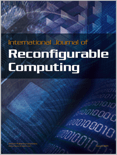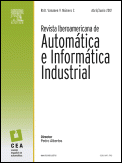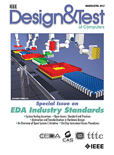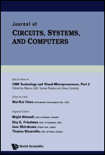
DESIGN AUTOMATION FOR EMBEDDED SYSTEMS
Scope & Guideline
Exploring Cutting-Edge Techniques in Embedded Systems
Introduction
Aims and Scopes
- Embedded System Design Automation:
The journal emphasizes automation in the design of embedded systems, exploring methodologies that enhance efficiency in hardware and software integration. - Hardware-Software Co-Design:
A consistent focus on co-design methodologies that optimize both hardware and software components to improve system performance and resource utilization. - Innovative Architectures and Technologies:
Research on novel architectures, including FPGA, RRAM, and CGRA, that push the boundaries of traditional embedded systems, allowing for enhanced capabilities and performance. - Energy Efficiency and Performance Optimization:
Significant attention is given to techniques and methodologies aimed at optimizing energy consumption and performance in embedded systems, particularly in real-time applications. - Machine Learning and AI Integration:
The journal explores the application of machine learning and AI techniques in embedded systems, particularly for enhancing functionalities like predictive control and real-time data processing. - Real-Time Systems and Timing Analysis:
Focus on the challenges and solutions related to timing, scheduling, and performance monitoring in real-time embedded systems.
Trending and Emerging
- Edge Computing and IoT Integration:
There is a marked increase in research focusing on edge AI and IoT applications, emphasizing distributed learning and real-time data processing to enhance system efficiency. - Hardware Acceleration for AI and Machine Learning:
Emerging themes include the design of specialized hardware accelerators for deep learning applications, indicating a growing interest in optimizing AI workloads on embedded systems. - Adaptive and Resilient Systems Design:
Research on adaptive systems that can withstand environmental challenges, such as radiation resilience for satellite applications, is gaining traction, highlighting the need for robust designs. - Resource Management in Multi-Core Systems:
Increasing publications on efficient resource management strategies for multi-core architectures suggest a trend towards maximizing performance in complex embedded environments. - Security and Trust in Embedded Systems:
Growing concerns around cybersecurity and system integrity have led to an uptick in research focused on trusted execution environments and secure design practices.
Declining or Waning
- General Purpose Embedded Computing:
Research related to generic embedded computing systems appears to be declining, possibly due to the increasing specialization of systems tailored for specific applications, such as IoT and automotive. - Legacy Systems and Outdated Technologies:
There is a noticeable reduction in publications addressing older technologies and legacy systems, reflecting a shift towards more contemporary and innovative solutions in embedded design. - Low-Level Hardware Design Techniques:
Research focused on traditional low-level hardware design methodologies seems to be waning, with a growing preference for higher-level abstractions and automated design tools. - Broad Spectrum Networking Protocols:
Themes centered around general networking protocols for embedded systems are less frequently explored, possibly as focus shifts towards more targeted communication protocols for specific applications.
Similar Journals

Journal of Electrical and Computer Engineering
Exploring the Frontiers of Electrical and Computer EngineeringJournal of Electrical and Computer Engineering is a premier open-access journal published by HINDAWI LTD, dedicated to advancing the fields of electrical and computer engineering. With an ISSN of 2090-0147 and an E-ISSN of 2090-0155, this journal has been providing a platform for cutting-edge research since its inception in 2007. Based in the United States, it operates from its address at ADAM HOUSE, 3RD FLR, 1 FITZROY SQ, LONDON W1T 5HF, ENGLAND. The journal has established itself with a healthy impact factor, classified in the 2023 Q2 quartile for both Computer Science (Miscellaneous) and Electrical and Electronic Engineering, demonstrating its growing influence in the academic community. Additionally, its ranking positions it within the 67th percentile in General Computer Science and the 61st percentile in Electrical and Electronic Engineering on Scopus, indicating its significant contribution to these fields. Covering an extensive scope from 2010 to 2024, the journal seeks to publish innovative research articles, reviews, and case studies that explore new techniques and applications in electrical and computer engineering, benefiting a wide audience of researchers, professionals, and students focused on these rapidly-evolving areas.

International Journal of Reconfigurable Computing
Empowering Innovations in Hardware FlexibilityWelcome to the International Journal of Reconfigurable Computing, a leading open-access platform dedicated to the exploration of innovative methodologies and applications in the field of reconfigurable computing. Published by HINDAWI LTD, this journal has been fostering scholarly communication since its inception in 2008. With an ISSN of 1687-7195 and an E-ISSN of 1687-7209, it offers researchers valuable access to the latest advancements and trending research in hardware and architecture, evidenced by its quarterly ranking in the Q4 category for 2023. Researchers, professionals, and students alike will find this journal an invaluable resource for staying updated in a rapidly evolving domain, notwithstanding its current Scopus ranking of 154 out of 177 within its category, reflecting a burgeoning opportunity for growth and engagement in this niche. Submitting their research to the International Journal of Reconfigurable Computing not only connects authors with a global audience but also contributes to the collective advancement of knowledge in this critical area. Explore the vast potential of reconfigurable systems and become part of a community dedicated to pushing the boundaries of computing technology.

Revista Iberoamericana de Automatica e Informatica Industrial
Advancing Automation through Open Access ResearchRevista Iberoamericana de Automatica e Informatica Industrial (ISSN: 1697-7912, E-ISSN: 1697-7920) is a distinguished open-access journal published by UNIV POLITECNICA VALENCIA, EDITORIAL UPV, since its inception in 2007. Based in Valencia, Spain, the journal aims to foster the dissemination of high-quality research in the fields of automation and industrial informatics. With a commendable impact reflected in its 2023 Scopus rankings—Q2 in Computer Science (miscellaneous) and Q3 in Control and Systems Engineering—it serves as a pivotal platform for innovative contributions from both established researchers and emerging scholars. The journal is committed to accessibility, ensuring that all articles are freely available to a global audience, promoting collaborative advancement in technology and engineering. Its coverage spans from 2007 to 2024, making it a valuable resource for those engaged in cutting-edge research and applications in the interdisciplinary landscape of computer science and engineering.

Journal of Control Automation and Electrical Systems
Pioneering Insights in Control Systems and AutomationThe Journal of Control Automation and Electrical Systems, published by SPRINGER, is a prominent academic journal dedicated to advancing research in the interdisciplinary fields of control systems, automation, and electrical engineering. With an ISSN of 2195-3880 and E-ISSN of 2195-3899, this journal has emerged as a vital platform for disseminating high-quality research, contributing significantly to both theoretical and applied aspects of these interrelated domains. As of 2023, it ranks in the Q2 and Q3 quartiles across multiple categories, including Electrical and Electronic Engineering and Energy Engineering, showcasing its relevance and impact in the field. Although not an open-access journal, it provides rich access options for research works, ensuring that findings reach a wide audience. Researchers, professionals, and students alike can draw valuable insights from its curated articles that explore emerging trends, innovative technologies, and practical applications, thus reinforcing its position as a key contributor to the advancement of control and automation systems.

ACM Transactions on Reconfigurable Technology and Systems
Advancing the Frontiers of Reconfigurable TechnologyACM Transactions on Reconfigurable Technology and Systems is a leading journal in the field of computer science, specifically focusing on the rapidly evolving area of reconfigurable technology. Published by the esteemed Association for Computing Machinery, this journal provides a vital platform for researchers and practitioners to share groundbreaking findings and innovative methodologies that drive advancements in system design, architecture, and implementation. The journal boasts a commendable impact factor and has positioned itself within the top quartile (Q1) of computer science journals as of 2023, with a notable Scopus rank of #64 out of 232 in the General Computer Science category, placing it in the 72nd percentile. As a trusted resource for the latest developments from 2008 to 2024, the journal encourages submissions that challenge conventional approaches and propose novel solutions in reconfigurable technologies. Although it is not open access, it continues to strive for accessibility and dissemination of knowledge that is critical for academics, industry professionals, and students alike.

MEASUREMENT & CONTROL
Exploring New Frontiers in Measurement and ControlMEASUREMENT & CONTROL is a prominent journal published by SAGE PUBLICATIONS LTD, dedicated to advancing the fields of applied mathematics, control systems, and instrumentation. With an ISSN of 0020-2940 and an E-ISSN of 2051-8730, this open-access journal has been serving the academic community since 1968, ensuring that essential research findings are accessible to all. As of 2023, it is recognized within the Q3 quartile of Scopus rankings in key categories including Applied Mathematics, Control and Optimization, and Instrumentation, highlighting its relevance in an ever-evolving scientific landscape. The journal not only fosters high-quality research but also encourages the exchange of innovative ideas and techniques, making it an essential resource for researchers, professionals, and students alike. With a focus on the latest advancements and methodologies, MEASUREMENT & CONTROL remains a vital platform for disseminating knowledge and fostering collaboration within these interdisciplinary fields.

International Journal of Embedded Systems
Exploring Innovations in Hardware and Software IntegrationInternational Journal of Embedded Systems, published by INDERSCIENCE ENTERPRISES LTD, is a pivotal platform for researchers and professionals engaged in the dynamic fields of embedded systems, hardware, and software architecture. Established in 2005, this journal addresses the intricate interplay between software and hardware components in embedded system design and offers valuable insights into the latest advancements and methodologies. With its ISSN 1741-1068 and E-ISSN 1741-1076, it showcases rigorous peer-reviewed articles that contribute significantly to ongoing discourse and innovation in the field. Despite its current ranking in the Q4 category for both Hardware and Architecture and Software, the journal serves as a crucial resource for the development and enhancement of embedded technology. Researchers are encouraged to explore this journal to stay abreast of emerging trends and foster collaborations that advance knowledge in this complex domain. Note that the journal does not currently offer open access options, which may affect dissemination and accessibility for the wider academic community.

IEEE Design & Test
Innovating Design and Testing for Tomorrow's TechnologiesIEEE Design & Test is a leading academic journal published by the IEEE-INST ELECTRICAL ELECTRONICS ENGINEERS INC, dedicated to advancing the fields of Electrical and Electronic Engineering, Hardware and Architecture, and Software. With an ISSN of 2168-2356 and an E-ISSN of 2168-2364, the journal spans from 2013 to 2024, offering valuable insights and peer-reviewed research that addresses critical challenges in the design, verification, and testing of electronic systems. Recognized for its quality, the journal holds a Q2 designation in Electrical and Electronic Engineering and ranks within the top quartiles of its category, making it a notable resource for professionals and scholars alike. Its Scopus rankings, particularly a rank of #354 in Electrical and Electronic Engineering, underscores its significance and relevance in the rapidly evolving technological landscape. Although not currently open access, the journal remains committed to disseminating innovative research that shapes the future of technology, ensuring that researchers and practitioners stay at the forefront of their disciplines. IEEE Design & Test serves as an essential platform for exchanging ideas, fostering collaboration, and driving advancements in engineering and computer science.

ACM Journal on Emerging Technologies in Computing Systems
Unveiling Breakthroughs in Computing TechnologiesACM Journal on Emerging Technologies in Computing Systems, published by the Association for Computing Machinery, stands as a premier platform dedicated to the exploration and discussion of avant-garde advancements in computing systems. With an ISSN of 1550-4832 and an E-ISSN of 1550-4840, this journal has achieved notable recognition, holding a 2023 Q2 ranking in key fields such as Electrical and Electronic Engineering, Hardware and Architecture, Nanoscience and Nanotechnology, and Software. Spanning from 2005 to 2024, it provides a critical forum for researchers, professionals, and students alike to disseminate innovative research and applications that shape the future of technology. Although currently not open access, the journal's commitment to high-quality, peer-reviewed content ensures its relevance and impact, as reflected in its competitive Scopus ranks across various disciplines. Engage with groundbreaking research that propels the frontiers of computational systems in this dynamic academic journal.

JOURNAL OF CIRCUITS SYSTEMS AND COMPUTERS
Pioneering Insights in Circuit Systems and Computer TechnologiesJOURNAL OF CIRCUITS SYSTEMS AND COMPUTERS is a pivotal publication in the fields of Electrical and Electronic Engineering as well as Hardware and Architecture, published by World Scientific Publishing Co. Pte Ltd in Singapore. With an ISSN of 0218-1266 and an E-ISSN of 1793-6454, this journal has contributed significantly to the discourse surrounding innovative research and technological advancements since its inception in the late 1990s. It currently holds a Q3 ranking in both relevant categories, reflecting its competitive stature and providing researchers, professionals, and students a substantial platform for disseminating findings. The journal covers a diverse range of topics, focusing on the design, analysis, and application of circuits, systems, and advanced computing technologies. Authors benefit from a rigorous peer-review process, ensuring high-quality publications that drive the field forward. The journal's commitment to excellence underscores its importance in fostering academic collaboration and knowledge exchange, making it a vital resource for anyone dedicated to advancing the domains of electrical engineering and computer science.